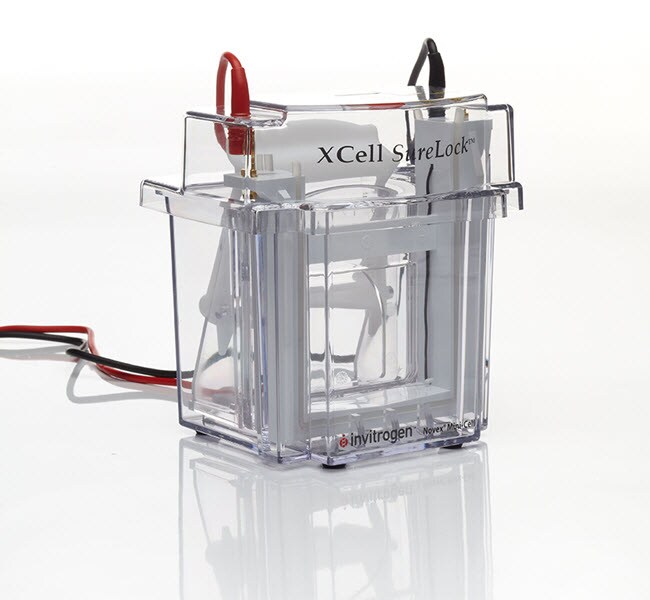Search Thermo Fisher Scientific

XCell SureLock™ Mini-Cell
| Catalog Number | Quantity |
|---|---|
| EI0001 | 1 unit |
See all available electrophoresis chamber systems ›
How the system works
The XCell SureLock Mini-Cell holds gels firmly with a simple gel tension wedge. When the lever on the gel tension wedge is pushed forward into the locked position, an even, horizontal force is generated. This seals the gel/buffer core assembly firmly into position in the lower buffer chamber. The positive locking action of the gel tension wedge ensures a trouble-free, leak-free gel run every time.
The XCell SureLock Mini-Cell can be used for wet transfers using the XCell II Blot Module. The XCell II Blot Module is used in place of the gel/buffer core assembly. It requires less than 200 mL of transfer buffer for western, southern, and northern transfers. Tough platinized titanium and stainless steel electrodes create a uniform electrical field without clamps or hinged gel holders. Maximum blot size is 9 cm x 9 cm.

Introducing iBlot 3 Western Blot Transfer System
Featuring higher throughput and built-in cooling for consistent protein transfer
Learn more ›
Figures



Customers who viewed this item also viewed
Documents & Downloads
Certificates
Frequently asked questions (FAQs)
No. The FMC gels are 10 cm x 10 cm but are slightly thinner so they do not fit properly in the XCell SureLock unit, and as a result the inner buffer chamber will leak.
Find additional tips, troubleshooting help, and resources within our Protein Electrophoresis and Western Blotting Support Center.
The most common cause of abnormally high current is the transfer buffer. If the transfer buffer is too concentrated, this leads to increased conductivity and current. High current may also occur if Tris-HCl is accidentally substituted for the Tris base required in the transfer buffer. This will again result in low buffer pH and lead to increased conductivity and current and subsequently, overheating. We recommend checking the transfer buffer and its reagent components and re-diluting or remaking the buffer.
Find additional tips, troubleshooting help, and resources within our Protein Electrophoresis and Western Blotting Support Center.
- Increase the pH of Tris-Glycine transfer buffer to 9.2, allowing all the proteins below pI 9.2 to transfer towards the anode electrode.
- Use the Tris-Glycine transfer buffer and place a membrane on both sides of the gel. If there are any proteins that are more basic than the pH of the transfer buffer, they will be captured on the extra membrane placed on the cathode side of the gel. Both membranes can then be developed in the same manner.
- Prior to blotting, incubate the gel for 15 minutes in Tris-Glycine transfer buffer containing 0.1% SDS. The small amount of SDS will give the proteins enough charge to move unidirectionally towards the anode and in most cases, should not denature the protein. Proceed with the transfer using regular Tris-Glycine transfer buffer.
Find additional tips, troubleshooting help, and resources within our Protein Electrophoresis and Western Blotting Support Center.
For proteins larger than 100 kDa, we recommend pre-equilibrating the gel in 2X NuPAGE Transfer buffer (without methanol) containing 0.02-0.04% SDS for 10 minutes before assembling the sandwich and then transferring using 1X NuPAGE transfer buffer containing methanol and 0.01% SDS.
Find additional tips, troubleshooting help, and resources within our Protein Electrophoresis and Western Blotting Support Center.
Here are possible causes and solutions:
- Presence of air bubbles between the gel and the membrane preventing the transfer of proteins. Be sure to remove all air bubbles between the gel and membrane by rolling a glass pipette over the membrane surface.
- Expired or creased membranes used. Use fresh, undamaged membranes.
Find additional tips, troubleshooting help, and resources within our Protein Electrophoresis and Western Blotting Support Center.